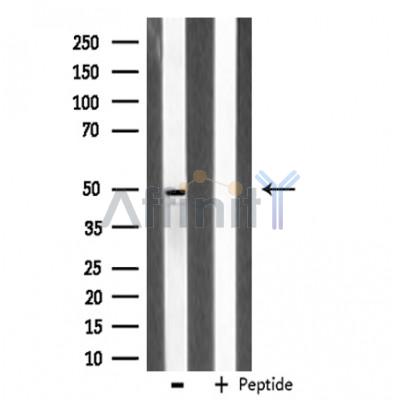Adrenergic Receptor alpha -2A Antibody - #DF3076
| Product: | Adrenergic Receptor alpha -2A Antibody |
| Catalog: | DF3076 |
| Description: | Rabbit polyclonal antibody to Adrenergic Receptor alpha -2A |
| Application: | WB IHC IF/ICC |
| Cited expt.: | WB |
| Reactivity: | Human, Mouse, Rat |
| Prediction: | Pig, Zebrafish, Bovine, Rabbit, Chicken |
| Mol.Wt.: | 48 KD; 51kD(Calculated). |
| Uniprot: | P08913 |
| RRID: | AB_2835459 |
Related Downloads
Protocols
Product Info
*The optimal dilutions should be determined by the end user.
*Tips:
WB: For western blot detection of denatured protein samples. IHC: For immunohistochemical detection of paraffin sections (IHC-p) or frozen sections (IHC-f) of tissue samples. IF/ICC: For immunofluorescence detection of cell samples. ELISA(peptide): For ELISA detection of antigenic peptide.
Cite Format: Affinity Biosciences Cat# DF3076, RRID:AB_2835459.
Fold/Unfold
ADA2A_HUMAN; ADRA2; ADRA2A; ADRA2R; ADRAR; Adrenergic alpha 2A receptor; Alpha 2 adrenergic receptor subtype C10; Alpha 2A adrenergic receptor; Alpha 2AAR subtype C10; Alpha-2 adrenergic receptor subtype C10; alpha-2-adrenergic receptor, platelet type; Alpha-2A adrenergic receptor; Alpha-2A adrenoceptor; Alpha-2A adrenoreceptor; Alpha-2AAR; ALPHA2AAR; OTTHUMP00000058849; ZNF32;
Immunogens
A synthesized peptide derived from human Adrenergic Receptor alpha -2A, corresponding to a region within the internal amino acids.
- P08913 ADA2A_HUMAN:
- Protein BLAST With
- NCBI/
- ExPASy/
- Uniprot
MFRQEQPLAEGSFAPMGSLQPDAGNASWNGTEAPGGGARATPYSLQVTLTLVCLAGLLMLLTVFGNVLVIIAVFTSRALKAPQNLFLVSLASADILVATLVIPFSLANEVMGYWYFGKAWCEIYLALDVLFCTSSIVHLCAISLDRYWSITQAIEYNLKRTPRRIKAIIITVWVISAVISFPPLISIEKKGGGGGPQPAEPRCEINDQKWYVISSCIGSFFAPCLIMILVYVRIYQIAKRRTRVPPSRRGPDAVAAPPGGTERRPNGLGPERSAGPGGAEAEPLPTQLNGAPGEPAPAGPRDTDALDLEESSSSDHAERPPGPRRPERGPRGKGKARASQVKPGDSLPRRGPGATGIGTPAAGPGEERVGAAKASRWRGRQNREKRFTFVLAVVIGVFVVCWFPFFFTYTLTAVGCSVPRTLFKFFFWFGYCNSSLNPVIYTIFNHDFRRAFKKILCRGDRKRIV
Predictions
Score>80(red) has high confidence and is suggested to be used for WB detection. *The prediction model is mainly based on the alignment of immunogen sequences, the results are for reference only, not as the basis of quality assurance.
High(score>80) Medium(80>score>50) Low(score<50) No confidence
Research Backgrounds
Alpha-2 adrenergic receptors mediate the catecholamine-induced inhibition of adenylate cyclase through the action of G proteins. The rank order of potency for agonists of this receptor is oxymetazoline > clonidine > epinephrine > norepinephrine > phenylephrine > dopamine > p-synephrine > p-tyramine > serotonin = p-octopamine. For antagonists, the rank order is yohimbine > phentolamine = mianserine > chlorpromazine = spiperone = prazosin > propanolol > alprenolol = pindolol.
Cell membrane>Multi-pass membrane protein.
Belongs to the G-protein coupled receptor 1 family. Adrenergic receptor subfamily. ADRA2A sub-subfamily.
Research Fields
· Environmental Information Processing > Signal transduction > cGMP-PKG signaling pathway. (View pathway)
· Environmental Information Processing > Signaling molecules and interaction > Neuroactive ligand-receptor interaction.
References
Application: WB Species: Mouse Sample: TKPTS cells
Restrictive clause
Affinity Biosciences tests all products strictly. Citations are provided as a resource for additional applications that have not been validated by Affinity Biosciences. Please choose the appropriate format for each application and consult Materials and Methods sections for additional details about the use of any product in these publications.
For Research Use Only.
Not for use in diagnostic or therapeutic procedures. Not for resale. Not for distribution without written consent. Affinity Biosciences will not be held responsible for patent infringement or other violations that may occur with the use of our products. Affinity Biosciences, Affinity Biosciences Logo and all other trademarks are the property of Affinity Biosciences LTD.

